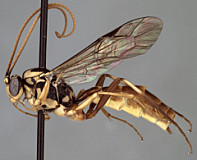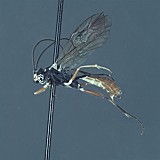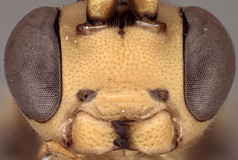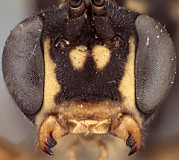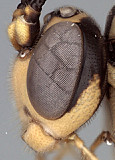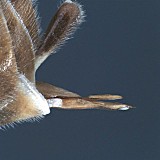Clypeus (Figs 3, 4) relatively narrow, usually flat to weakly bulging; ventral margin sharp throughout, truncate to weakly concave medially, with lateral margins distinctly angled dorsally; epistomal sulcus sharply setting off face from clypeus. Malar space shorter than half basal width of mandible, very short in some individuals. Mandible (Fig. 3) short, curved; narrowing from base to apex; dorsal tooth wider and usually slightly longer than ventral tooth; ventral margin carinate. Inner eye margins parallel to weakly converging. Ocelli with maximum diameter of lateral ocellus often about equal to distance between ocellus and eye. Maxillary palp shorter than height of head. Antennae shorter than or about equal to length of body (Fig. 1); first flagellomere varying from about 1.7-2.0 times longer than second. Hypostomal carina joining occipital carina well above base of mandible; occipital carina complete. Epomia absent in at least one species, present in others (or with epomia-like sculpture). Dorsal end of epicnemial carina usually not extending to anterior margin of mesopleuron, weakly to very distinctly separated from anterior margin; mesopleuron varying from coarsely to finely punctate; mat. Notaulus varying from absent or nearly so to very short but distinctly impressed on dorsal part of anterior declivity. Pleural carina usually distinct throughout; propodeal carinae variously reduced: lateral longitudinal carina usually weak, sometimes indistinct; petiolar area usually broad, hemispherical, and completely delimited by tall carinae, more rarely with carinae absent or very weak medially; median carinae absent or weak and irregular. Legs with apical comb on posterior side of hind tibia poorly developed, indistinct; hind tibial spurs long, slender (Figs 2, 6, 7), longest spur usually nearly as long as half length of very long hind basitarsus; all tarsal claws apparently simple, not pectinate. Fore wing areolet present; stigma not exceptionally broad, with Rs+2r arising from or near midpoint. Hind wing with first abscissa of CU1 slightly to distinctly longer than 1cu-a. T1 gradually widening posteriorly; dorsal carinae usually sharp and well-developed around margins of deep, wide basal depression of dorsal tendon attachment, rounded posteriorly, usually weakly extending to or posterior to level of spiracle; dorsal-lateral carina sharp and distinct from spiracle to base, and from spiracle to posterior margin of T1 in three of four species (rounded posteriorly in
contortionis); glymma deep. S1 not extending to level of spiracle. T2 thyridium present; laterotergites of T2 and T3 completely separated by creases. Ovipositor (Figs 1, 8) short, more or less straight, with deep, broad subapical, dorsal notch; ovipositor sheath shorter than hind tibial spur. Apex of female metasoma as in Fig. 8; somewhat compressed in females of two of three species examined in which females were available.
This description is considerably modified from Townes (1970) and based largely on four species in the Texas A&M University Collection.

